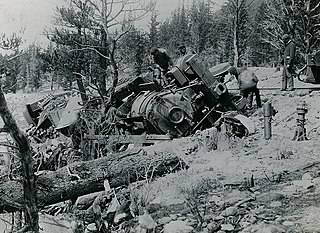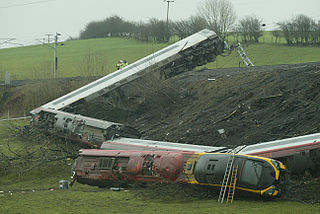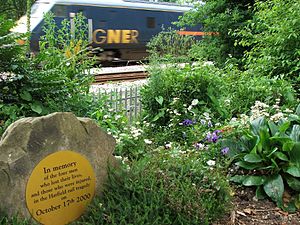
Railtrack was a group of companies that owned the track, signalling, tunnels, bridges, level crossings and all but a handful of the stations of the British railway system from 1994 until 2002. It was created as part of the privatisation of British Rail, listed on the London Stock Exchange, and was a constituent of the FTSE 100 Index. In 2002, after experiencing major financial difficulty, most of Railtrack's operations were transferred to the state-controlled non-profit company Network Rail. The remainder of Railtrack was renamed RT Group plc and eventually dissolved on 22 June 2010.

Network Rail Limited is the owner and infrastructure manager of most of the railway network in Great Britain. Network Rail is a non-departmental public body of the Department for Transport with no shareholders, which reinvests its income in the railways.
The Ladbroke Grove rail crash was a rail accident which occurred on 5 October 1999 at Ladbroke Grove in London, England, when two passenger trains collided almost head-on after one of them had passed a signal at danger. With 31 people killed and 417 injured, it was one of the worst rail accidents in 20th-century British history.

There have been four railway accidents at Potters Bar (England). Those in 1898 and 1946 were signals passed at danger. The accident in 2002 led to substantial public debate and a national change in policy relating to maintenance of infrastructure.
The privatisation of British Rail was the process by which ownership and operation of the railways of Great Britain passed from government control into private hands. Begun in 1994, the process was largely completed by 1997. The deregulation of the industry was in part motivated by the enactment of EU Directive 91/440 in 1991, which aimed to create a more efficient railway network by creating greater competition.

A train wreck, train collision, train accident or train crash is a type of disaster involving one or more trains. Train wrecks often occur as a result of miscommunication, as when a moving train meets another train on the same track; or an accident, such as when train wheels come off a track in a derailment; or when a boiler explosion occurs. Train wrecks have often been widely covered in popular media and in folklore.

In rail transport, a derailment is a type of train wreck that occurs when a rail vehicle such as a train comes off its rails. Although many derailments are minor, all result in temporary disruption of the proper operation of the railway system and they are a potentially serious hazard.

The Southall rail crash occurred on 19 September 1997, on the Great Western Main Line at Southall, West London. An InterCity 125 high speed passenger train (HST) failed to slow down in response to warning signals and collided with a freight train crossing its path, causing seven deaths and 139 injuries.
The 1996 Stafford rail crash occurred on 8 March 1996 when a Transrail freight train travelling from Mossend, North Lanarkshire, to Willesden, North London, derailed after an axle on a wagon carrying liquid carbon dioxide failed due to fatigue at Rickerscote 1.4 miles (2.2 km) south of Stafford on the West Coast Main Line. Almost immediately after the derailment, a Travelling Post Office mail train hauled by a Rail Express Systems British Rail Class 86 electric locomotive collided with a section of the derailed freight train on the adjacent line and fouled the path of the TPO mail train. One person, a mail sorter, was killed in the crash and twenty others including the driver of the mail train were injured.

Gerald Michael Nolan Corbett DL is a businessman who was the chairman of the Marylebone Cricket Club (MCC). A businessman, over a long career he has been a director of thirteen public companies, seven of which he has chaired. He is currently chairman of Segro plc, the FTSE 100 international industrial property logistics group. He chaired Britvic plc for 12 years until September 2017. Britvic plc is the international soft drink company whose brands include Robinsons squash, J2O, Tango, Fruit Shoot, Ballygowan water and is also a bottler for PepsiCo. As chairman he led the flotation of Britvic in 2005. He was chairman of Betfair plc between 2012 and 2016 when Betfair merged with Paddy Power plc to create Paddy Power Betfair.

In the early evening of 8 August 1996, a Class 321 passenger train operated by Network SouthEast travelling from London Euston on the West Coast Main Line Down Slow line at around 110 km/h (68 mph) passed a signal at danger. Having applied the brakes it eventually stopped 203 m (222 yd) past the signal and was traversing the junction between the Down Slow line and the Up Fast line. An empty Class 321 coaching stock train approaching at roughly 80 km/h (50 mph) collided with the stationary passenger train approximately 700 m south of Watford Junction whilst progressing across the connections from the Up Slow line to the Up Fast line.
Sir Thomas Philip Winsor is a British arbitrator and mediator, lawyer, consultant and economic regulatory professional.

The Grayrigg derailment was a fatal railway accident that occurred at approximately 20:15 GMT on 23 February 2007, just to the south of Grayrigg, Cumbria, in the North West England region of the United Kingdom. The accident investigation concluded that the derailment was caused by a faulty set of points on the Down Main running line, controlled from Lambrigg ground frame. The scheduled inspection on 18 February 2007 had not taken place and the faults had gone undetected.

Jarvis plc (LSE: JRVS) was a British company that specialised in construction and civil engineering, with a focus on support services to the British railway industry during its latter years of operations.

The 2015 Oxnard train derailment occurred on February 24, 2015, at 5:44 a.m. local time when a Metrolink passenger train collided with a truck that a driver had mistakenly turned from Rice Avenue onto the tracks and became stuck. After impact, the train derailed at Oxnard, California, United States. As a result of the crash, the train engineer died from his injuries a week later and 32 passengers and crew members were injured. The truck driver exited his vehicle and ran from the scene prior to the crash; he sustained minor injuries that were unrelated to the crash sequence.

On 9 November 2016, a tram operated by Tramlink in London derailed and overturned on a sharp bend approaching a junction. Of 69 passengers, there were seven fatalities and 62 injured, 19 of whom sustained serious injuries. This was the first tram incident in the United Kingdom in which passengers died since 1959.
Steven Marshall was a British business executive. He studied accountancy and worked in finance at several companies before taking a leading role at Thorn plc in the 1990s. Marshall was finance director of Railtrack and then chief executive from November 2000 until the company was forced into administration in October 2001. He was later chairman of Balfour Beatty and Wincanton plc.

The Stonehaven derailment was a fatal railway accident that occurred at 09:38 BST on 12 August 2020, when a passenger train returning to Aberdeen hit a landslip, near Carmont, west of Stonehaven in Aberdeenshire, Scotland, following severe rain. Of the nine people aboard, three were killed, and six were injured.












